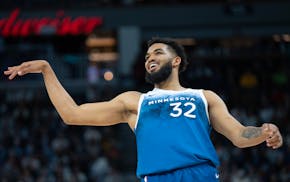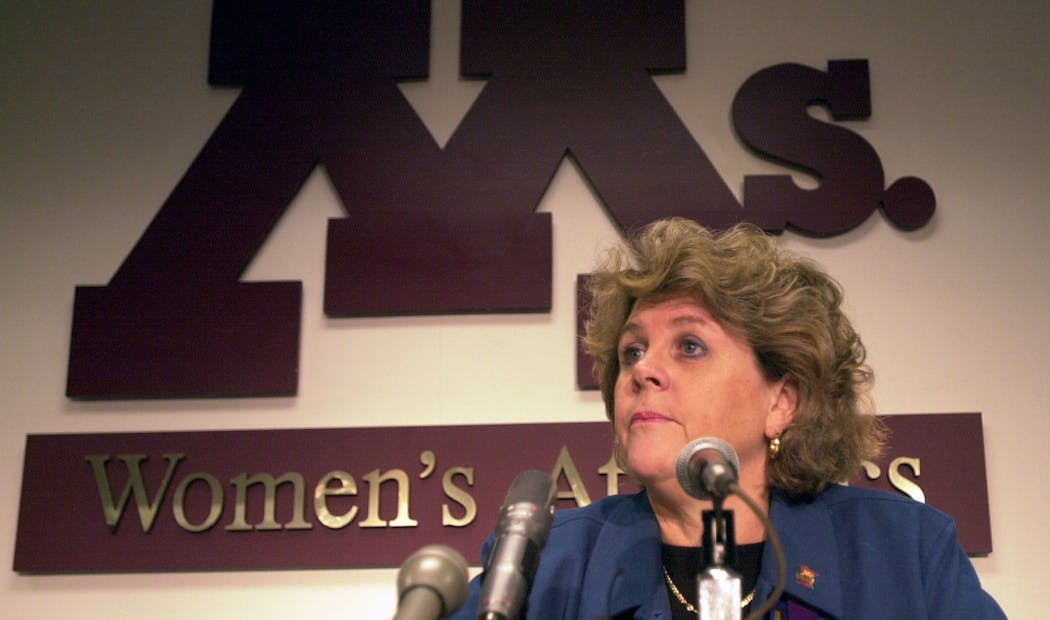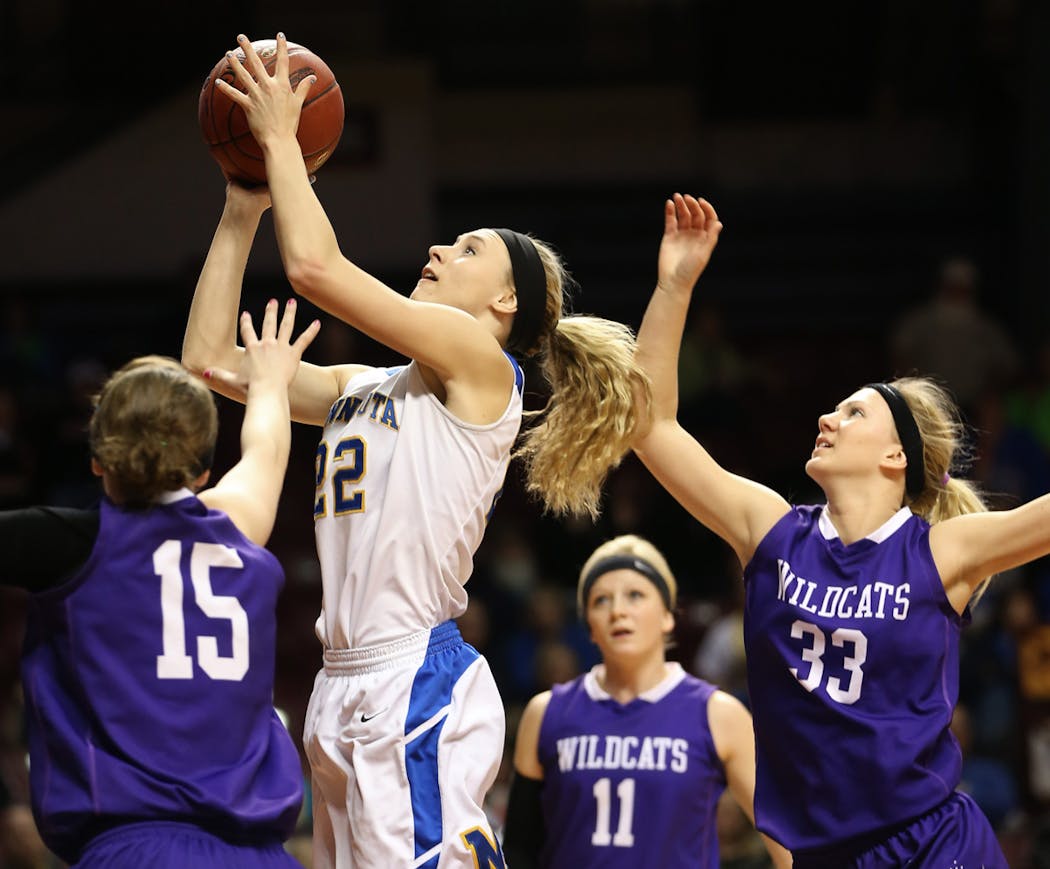MARSHALL, MINN. — The Honda Collegiate Women's Sports Awards were held June 24 at the Galen Center on the campus of Southern California. The awards for 2018-19 were honoring athletes from a dozen NCAA Division I sports, plus an inspirational athlete, and single athletes from Division II and Division III.
The awards have taken place for 43 years, soon after the dawning of the Title IX era, and Chris Voelz has been the executive director since 2012.
As you may recall, Voelz was the driven, controversial women's athletic director at the University of Minnesota from 1988 to 2002, until the university used the excuse of the one-AD model (Joel Maturi) to end her stay.
Left in Voelz' wake was an already outstanding volleyball program, a home for the softball team, a women's hockey arena that was just being completed, and numerous feuds — perhaps even one with yours truly.
In retrospect, we all must say that Voelz fought with great feistiness for the cause of what's become a terrific women's athletic program. And there's now evidence that Voelz remains a Gopher at heart, 17 years after the somewhat acrimonious parting.
Taylor Reiss, a volleyball whirlwind from the Minnesota prairie, received the Honda Award for Division II. To repeat: Not the Division II Honda for volleyball — the Division II Honda for everything.
Taylor was being interviewed this week on her home campus of Southwest Minnesota State in Marshall, and I asked her: "Did you get a chance to talk with our old friend Chris Voelz?''
Reiss smiled and said: "Yes, I did. We talked for a couple of minutes. All the athletes filled out a short bio, and mine included the information that Penn State was my favorite team to watch as a youngster, and that Megan Hodge (PSU, 2006-2009) was my favorite player.
"Chris Voelz congratulated me, and added that she was disappointed to see that I was a Penn State fan growing up more than a Gophers' fan. She was joking.
"Sort of.''
This interview was in a room near SMSU's large gymnasium. Inside, there was a scrimmage taking place between what have been the two high school power programs in this area:
Marshall and Minneota high schools, the latter of which is Reiss' alma mater, small town, small school, and a tradition of big success in several sports.
Reiss' four-year career for the Mustangs ended last November, with a five-set loss to their mighty Northern Sun rivals, Concordia of St. Paul, in the NCAA tournament. It also ended with Reiss being named the Division II National Player of the Year for the second straight season, and as the Northern Sun's offensive player of the year for the third straight season.
Among the Honda honorees that Reiss was able to spend time with was Kathryn Plummer, Stanford's two-time Division I player of the year, and a winner of two national championships (2016, 2018) in her three seasons with the Cardinal.
"Kathryn is great,'' Reiss said. "Funny. Smart. She made me feel like a real part of the awards. All the Division I athletes did that.''
Standing next to Plummer also served as a reminder to Reiss as to why Big Ten schools and other major programs did not journey to Minneota, or maybe to the family farm nearer to Taunton, to offer scholarships.
"I came up to here on Kathryn,'' Reiss said, pointing to her collarbone and laughing.
Plummer and Reiss both have earned their accolades as outside hitters. Plummer has done so at 6-foot-6. And Reiss? "I'm 5-foot-9, with my tennis shoes on,'' she said.
•••
Terry Culhane, the volleyball coaching pioneer in this area, is now starting his 16th season at Southwest Minnesota State. There has been plenty of success, and there would have been much more without the presence of the Concordia volleyball dynasty in St. Paul.
Culhane was blessed with the fantastic Mary Jo Miller at Milroy and then Tracy-Milroy high schools in volleyball and basketball in the 1980s. Mary Jo's husband, Chris Hmielewski, has been Culhane's boss for the past 14 years as Southwest State's athletic director.
And now two decades later, with outstanding athletes and much winning at Tracy-Milroy, and Marshall High School, and then as a college coach, Culhane has coached the athlete to compare with Miller — such a legend she's known merely as "Mary Jo'' in these parts.
Culhane does not buy the theory that the lack of height would have prevented Reiss from being effective at a higher level of competition.
"Taylor could have played a lot of places,'' he said. "She could have been a hitter at a few Big Ten schools, a few Big 12 schools. We were fortunate that she was comfortable in this area, she had been to matches when our gym was full, and that she really only looked at two schools.''
Those two were South Dakota State, an hour away in Brookings, and then Southwest. She signed with South Dakota State and coach Phil McDaniel in the fall of 2014. This coincided with the Jackrabbits going 6-27 overall and 0-16 in the Summit League that fall.
"He 'resigned' a week after I signed,'' said Reiss, attaching quote marks to resigned.
The new coach was Nicole Cirillo (now in her fifth season). Several of players Taylor had met on recruiting visits were gone. She stayed only a few days in preseason camp.
Megan Larson, Reiss' setter and close friend in Minneota, was a year ahead of Reiss in college, and at Southwest Minnesota State.
"I've been around Taylor so long, I can read her on the court and off it,'' Larson said. "She was unhappy. And I'm not going to lie: I was telling her, 'Come here. You'll enjoy it here.' And that came true.
"She was able to play in the best [Division II] volleyball conference in the country, and for a great coach in Terry Culhane. And every honor Taylor has received — those were deserved.''
•••
On the day after interviewing Reiss, I was at South Dakota State and spent an hour with Justin Sell, the athletic director. He was justified in extolling the many good things that have happened in Jackrabbits' athletics with its plunge into Division I.
It was with full naiveté that I asked: "How have you done in volleyball?''
Sell said: "That's the main program where we have struggled. I was at Northern Iowa. I saw what an outstanding volleyball program can do for a school. We hope to get there.''
Then he paused and said: "You talked with Taylor Reiss yesterday? We had her here, you know. She was so good. If she had stayed here, I think we would be farther down the road with a volleyball turnaround.''
That's quite a Division II player: When a candid athletic director can say she would have made a sizable difference (even at 5-9 in sneakers) for a Division I program.
"Taylor was a middle blocker in high school and she played there for us as a freshman,'' Culhane said. "In a normal rotation, middle blockers are out of the lineup much more often than an outside hitter.
"I went to Taylor at the start of her sophomore season and said, 'I don't like you being off the court so often. How about you?' And she said, 'I don't like it, either.'
"So, we moved her to hitter. It was an adjustment, the passing and defensive play required, but it didn't take her that long.''
Reiss said: "I thought it took me all year. I never felt like I was at my best as a sophomore. Then, I was named as a conference player of the year, with all the great players in the Northern Sun, and I thought: 'These people believe in me more than I believe in myself.'
"I think that realization was when I became the best player I could be.''
Reiss was a 5-foot-8 center on a state championship basketball team at Minneota. "I always could jump,'' she said. "That's how I got by as a center in basketball and a hitter in volleyball.''
Culhane talked about Tayor's leaping ability, and quickness, and hitting power, and instincts on the court, and resiliency in overcoming frequent tendinitis in her knees, and then said:
"A lot of coaches will say this about their athletes, but what really separated Taylor was her competitiveness. She was over-the-top in wanting to win.''
Reiss has a semester left to get a degree at Southwest Minnesota State. She also will be working in Mustangs' marketing department this fall. But she's done with collegiate volleyball, and the overseas pro teams aren't lining up for a 5-8 hitter, so where's the outlet for that ultracompetitive spirit?
"That's a very good question,'' Taylor Reiss, top Division II women's athlete in 2018-19, said. "I've been asking myself that. And so far, I don't have an answer.''

Reusse: Taylor's story. 'I just bought the Minnesota Timberwolves.'

Reusse: Back from injury, Towns doesn't have to carry load




